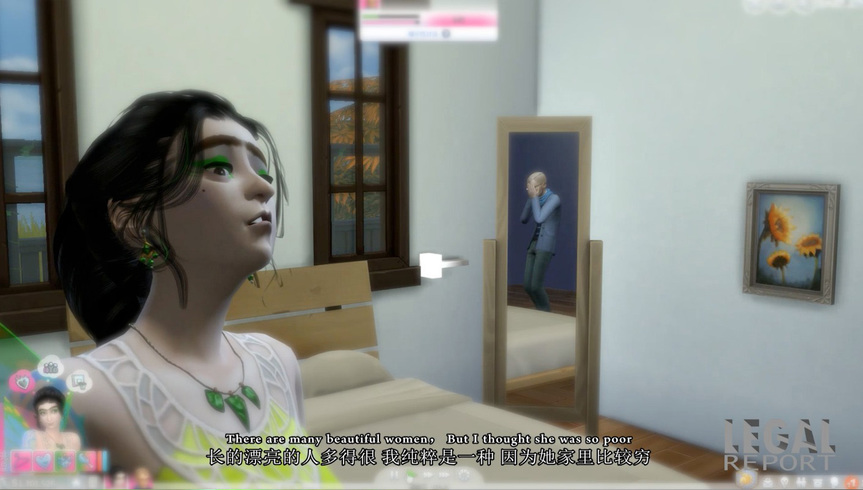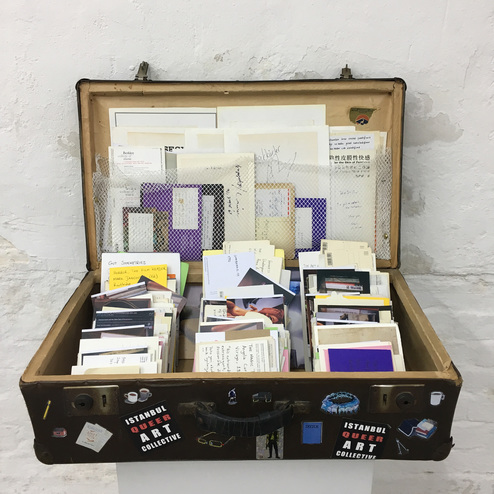
R
E
V N
E
X
T
Alternative Readings: Ye Funa and the Istanbul Queer Art Collective
ISTANBUL QUEER ART COLLECTIVE‘s latest rendition of Psychic Bibliophiles (2017) took place over Skype on June 19. The audience gathered in Istanbul’s Bilsart while the artists were in London. Courtesy Bilsart.
On the evening of June 19, a small crowd squeezed onto the wooden benches that had been set up in the cool concrete bunker of Istanbul’s Bilsart. We had gathered to watch Psychic Bibliophiles (2017), a performance by Tuna Erdem and Seda Ergul of the Istanbul Queer Art Collective, presented by Collective Çukurcuma as part of the show “Flow Out.”
Based in London, the Istanbul Queer Art Collective first performed Psychic Bibliophiles at the opening of Collective Çukurcuma’s “House of Wisdom” exhibition, hosted by Amsterdam’s Framer Framed in 2017. The flirtatious, cerebral duo took as their point of departure the books and magazines of their “dead” library, which they had to abandon when moving from Istanbul to London for personal and political reasons. Their imagined, supernatural reunion with their much-missed tomes encompassed off-the-cuff banter and freewheeling ruminations about the publications’ subjects.
Comprising the same gestures, delivered with the spirit of a friends-and-family gathering, or an after-hours student-teacher meeting, the inaugural rendition of Psychic Bibliophiles in Istanbul was special, as many in attendance were former students or proteges of Erdem and Ergul. The pair were unable to appear in person due to visa issues, but by presenting the work virtually, via a livestreamed projection, they were in pitch-perfect dialogue with the complementary project included in “Flow Out,” a video by Beijing-based artist Ye Funa, titled Flying Dance (2017).
Ye’s 30-minute video collage is from her Self-fiction series (2017– ), in which she probes the constructs of identities by roleplaying various characters. During a remote talk on May 29, also hosted at Bilsart, Ye spoke about her inspiration behind the group of works. “I reacted to the stories that I see on TV. This work is about women’s stories. Those women are controversial in China. They all have a dramatic life and tragic stories,” she said. “I’m always using myself as a character to research the life of real characters.”
For Flying Dance in particular, Ye plays a penniless Chinese immigrant student in Germany, whose name is Dong Mei. She presents herself as Fly to a German man called Old Jerk, who she meets at McDonalds. Old Jerk falls in love with Dong, who subsequently blackmails him with her false pregnancy. Interwoven with this storyline are scenes of Dong hanging out with a group of men as her wispy-bearded alter-ego known as Josh. Flying Dance was adapted from one of the first examples of online, Chinese-language fiction, The First Intimate Contact (1999), a love story by Taiwanese writer Tsai Jhi-heng. Ye interwove the aesthetics of early internet chatrooms and dating sites with recordings of Sims games and her original videography, underscoring the virtual, projected facets of what constitutes identity.
The trans-queerness of Ye’s video resonated with Psychic Bibliophiles. As part of the performance, the duo, dressed in in kitschy rainbow-colored outfits, asked volunteers to pick from the 2000 cards of their Just in Bookcase (2017). Each card has a cultural or erotic image on one side, and a literary or academic quote on the other. Local writer Kultigin K. Akbulut raised his hand, proclaiming his admiration for Erdem, whose film theory he has read since high school. Akbulut was invited to choose a card. His selection referred to the book Porn Studies (2004) by film studies scholar Linda Williams, and the icon was that of a winged fairy riding an erect penis.
The Collective touched on broad intellectual subjects as part of their reading of the text and images. Ergul professed their adoration of composer Steve Reich’s Writings on Music: 1965-2000 (2004). At one point, the pair waxed nostalgic for Beyoğlu, the core district on Istanbul’s historic European side. They had lived in the Çukurcuma neighborhood, where Naz Cuguoğlu and Mine Kaplangı formed Collective Çukurcuma.
While charming, the Istanbul performance of Psychic Bibliophiles felt weighed by a tedium of exclusivity. The Istanbul Queer Art Collective, despite being brightly comic and intellectually bracing, did not penetrate the mental boundary of their audience. Instead, their discussion revolved around recollections that, however thoughtful, often relayed points as obscure between them as they were for the passive, pseudo-participants.
Most walked away with an earful, smiling like a student who is happy because class has ended, and at least the professors have a sense of humor. Curator Kaplangı expressed, “I miss them dearly but I also admire and cherish their existence daily. I was never their student. I only heard magical things about their methods of teaching, methods of sharing.” It was self-evident by the excitement in the air how very much Erdem and Ergul mean for Istanbul’s queer artists and arts community. But whether or not Psychic Bibliophiles conveyed this intimacy to a global audience, or intended to, is a matter for mind readers.



















